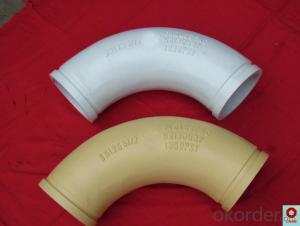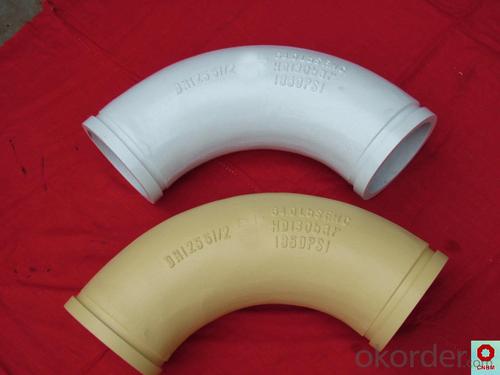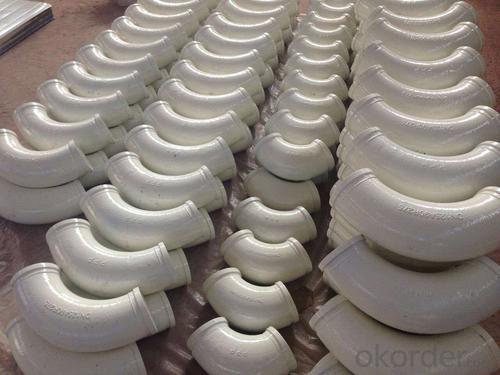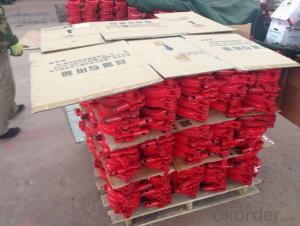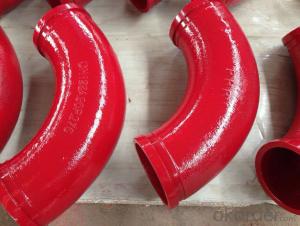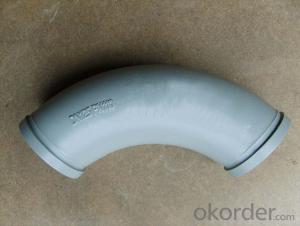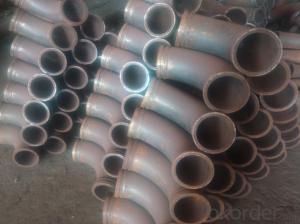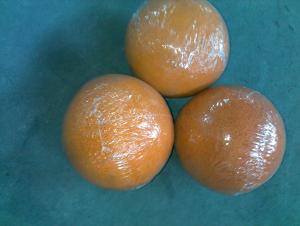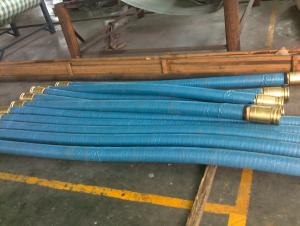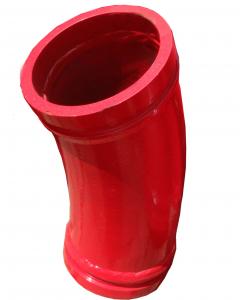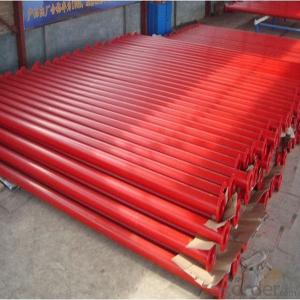CONCRETE DELIVERY ELBOW CIFATYPE 90DEG R275 DN125
- Loading Port:
- Tianjin
- Payment Terms:
- TT OR LC
- Min Order Qty:
- 100 pc
- Supply Capability:
- 10000 pc/month
OKorder Service Pledge
OKorder Financial Service
You Might Also Like
concrete pump elbow table
Wear-resistant Single or Double Concrete Pump Elbow | |||||||
Type | Singe Elbow | Double Elbow | |||||
Model | DN125 | DN150 | DN175 | DN125 | |||
Material | Casting Steel ,ST52 | Inside | 40Cr | Outside | |||
Size | R275*90° | R275*90°+110 | 36° | F2000 | R275*90° | R275*90°+110 | |
R275*45° | R275*90°+211 | R400*30° | A3000 | R275*45° | R275*90°+211 | ||
R275*25° | R275*90°+411 | R400*45° | 471B | R275*25° | R275*90°+411 | ||
R275*20° | R275*90°+424 | R400*30° | 571B | R275*20° | R275*90°+424 | ||
R275*15° | R275*45°+170 | R488*90° | A1000 | R275*15° | R275*45°+170 | ||
R180*90° | R275*45°+310 | R500*90 | C1000 | R180*90° | R275*45°+310 | ||
R232*60° | R275*45°+310 | R280*90° | B2000 | R232*60° | R275*45°+310 | ||
R240*36° | 20°Lengthen | R240*36° | 20°Lengthen | ||||
R240*30° | 25°+740 | R240*30° | 25°+740 | ||||
R240*15° | 40°Zoomlion | R240*15° | 40°Zoomlion | ||||
R385*29° | R385*29° | ||||||
R315*33° | R315*33° | ||||||
Technic | Forged | ||||||
Average life | 25,000cubic | 50,000cubic | |||||
Appliciation | Used in concrete transport in construction work | ||||||
1.product profile:The double layer concrete pump elbow is developed by ourselves through new
technology and process.
2.characteristic:the inner layer of this concrete pump elbow undergoes heat treatment,and then the rigitiry can reach 62-65HRC.
3.characteristic:the outer layer of the concrete pump elbow possess good toughness properties
to protect the inner layer,so the security of the elbow is improved.
4.life:the experiment done abroad shows that the life of our concrete pump elbow can reach 35000-50000cbm,got the customers' praise
5.Beside the double layer concrete pump elbow,we produce all kinds of concrete pump parts,
straight pipe hose flange coupling and so on.
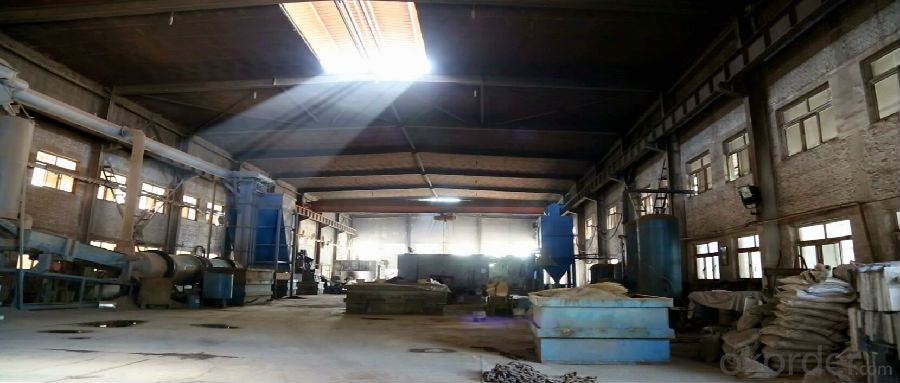
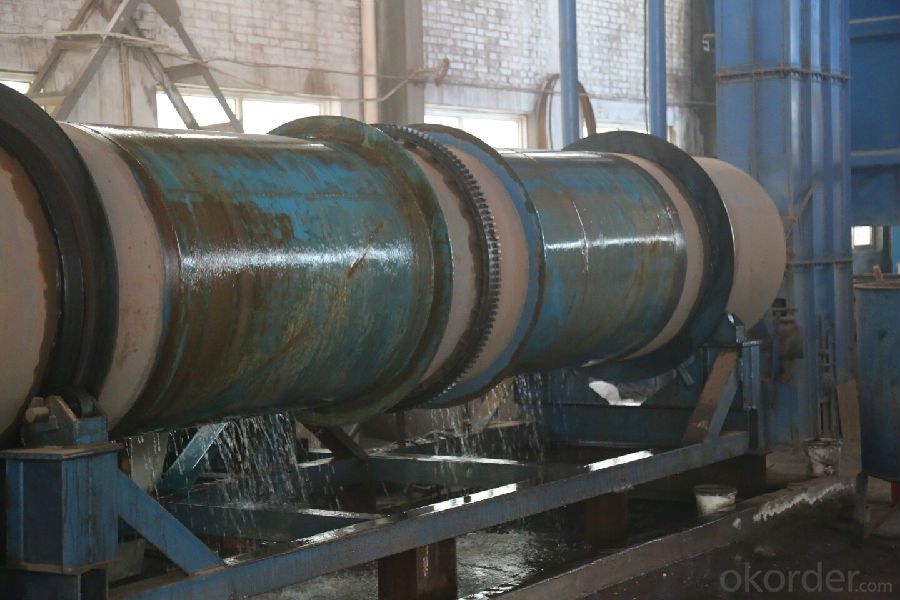
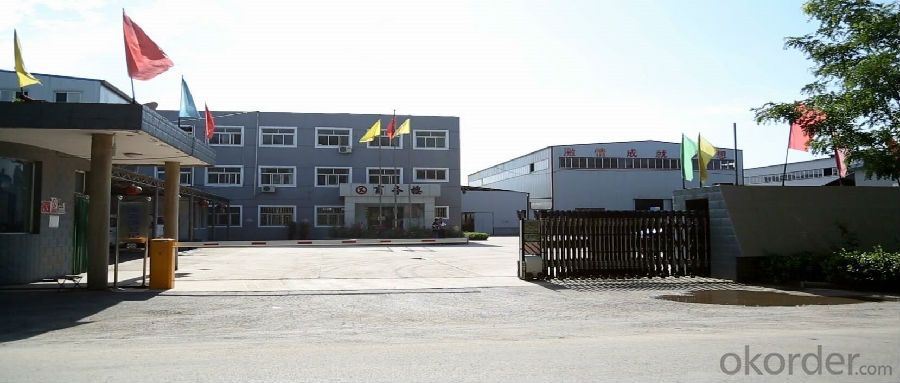
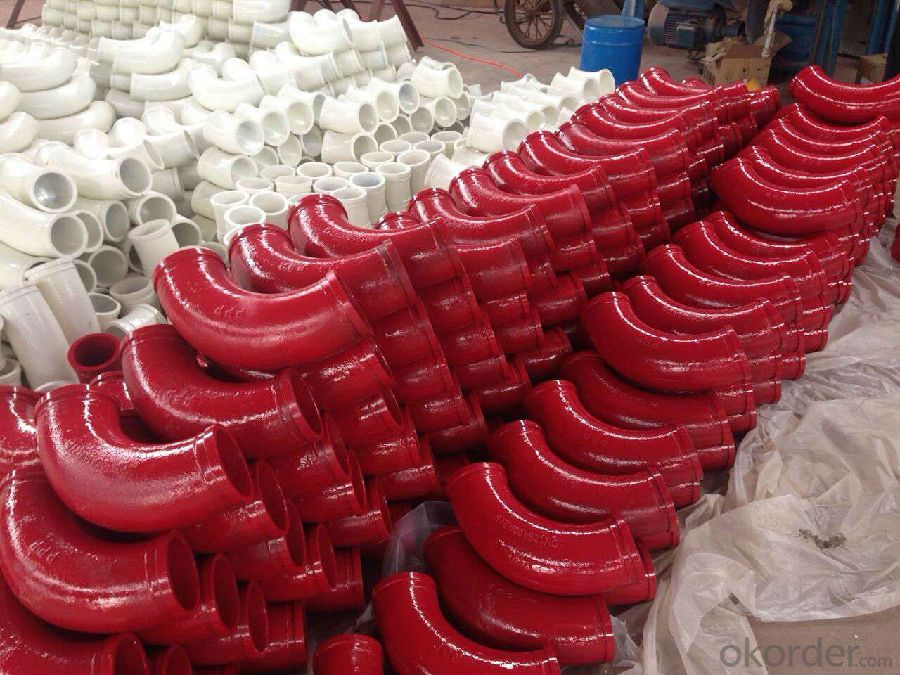
- Q: How can a faulty water pump affect the concrete pumping operation?
- A faulty water pump can have several negative effects on a concrete pumping operation. Firstly, a water pump is responsible for supplying water that is used to mix the concrete and maintain its proper consistency. If the water pump is faulty and not functioning correctly, it may not be able to supply the required amount of water, resulting in the concrete mix being too dry or not well-mixed. This can lead to a poor-quality concrete mix that is difficult to pump and may not set properly, compromising the structural integrity of the concrete. Additionally, a faulty water pump can affect the efficiency and productivity of the concrete pumping operation. If the pump is not working efficiently, it may take longer to mix and deliver the concrete, causing delays in the construction process. This can lead to increased costs and potential disruptions to project timelines. Furthermore, a faulty water pump can also impact the safety of the concrete pumping operation. Adequate water supply is essential for preventing the concrete from overheating during the pumping process. If the water pump fails to supply enough water, the concrete can heat up rapidly, leading to a phenomenon called thermal cracking. Thermal cracking weakens the concrete and can cause it to fail prematurely, posing a safety risk to workers and the overall structure. In summary, a faulty water pump can negatively impact a concrete pumping operation by resulting in poor-quality concrete mixes, decreased efficiency and productivity, and potential safety hazards. It is crucial to regularly inspect and maintain water pumps to ensure their proper functioning and prevent any detrimental effects on the concrete pumping process.
- Q: How can one identify the correct type of rubber seals or gaskets for concrete pump spare parts?
- To identify the correct type of rubber seals or gaskets for concrete pump spare parts, there are a few steps you can follow: 1. Consult the manufacturer's documentation: Check the concrete pump's manual or any accompanying documentation provided by the manufacturer. This information will usually specify the type and size of rubber seals or gaskets required for different parts of the pump. 2. Measure the dimensions: Take precise measurements of the seals or gaskets that need replacement. This includes the inner diameter, outer diameter, and thickness. These measurements will help you find the right size of seals or gaskets. 3. Material compatibility: Consider the material compatibility between the rubber seals or gaskets and the concrete being pumped. Concrete may contain chemicals or additives that can degrade certain types of rubber. Ensure that the seals or gaskets you choose are made of a material that is resistant to the specific chemicals present in the concrete. 4. Seek expert advice: If you are unsure about the specific type of rubber seal or gasket required for your concrete pump, it is always advisable to seek expert advice. Contact the manufacturer directly or consult a reputable supplier or distributor who specializes in concrete pump spare parts. They can provide guidance and recommend the correct type of seals or gaskets based on your specific pump model and requirements. Remember, using the correct type of rubber seals or gaskets is crucial for maintaining the efficiency and safety of your concrete pump. Taking the time to identify the right parts will help ensure optimal performance and minimize the risk of premature wear or failure.
- Q: How do I properly maintain and replace hydraulic hoses in concrete pump spare parts?
- Proper maintenance and replacement of hydraulic hoses in concrete pump spare parts involve a few essential steps. Firstly, it is crucial to regularly inspect the hoses for signs of wear, including cracks, leaks, or bulges. Any damaged hoses should be replaced immediately to avoid any potential accidents or disruptions in the pumping process. When replacing hydraulic hoses, it is essential to use high-quality hoses that are compatible with the concrete pump system. It is recommended to consult the manufacturer's guidelines or seek professional advice to ensure the correct specifications and fittings are used. During installation, make sure to properly clean and prepare the hose fittings and connections. This involves removing any debris or dirt that could cause contamination or hinder a secure connection. Additionally, it is essential to follow the recommended torque specifications when tightening the fittings to prevent over-tightening or under-tightening, which can lead to leaks or hose failure. Regular maintenance also includes regularly checking and replacing hydraulic oil and filters according to the manufacturer's recommendations. This helps to ensure optimal performance and prolong the lifespan of the hydraulic hoses and other components. Overall, proper maintenance and replacement of hydraulic hoses in concrete pump spare parts require regular inspections, the use of high-quality hoses, proper cleaning and preparation during installation, correct torque specifications, and adherence to manufacturer guidelines for maintenance and replacement intervals.
- Q: What are the signs of a clogged or damaged hydraulic filter?
- Some signs of a clogged or damaged hydraulic filter may include decreased hydraulic system performance, increased noise or vibration, higher operating temperatures, and contamination of the hydraulic fluid.
- Q: Are there any specific guidelines for the installation of seal kits or O-rings in concrete pump spare parts?
- Yes, there are specific guidelines for the installation of seal kits or O-rings in concrete pump spare parts. It is important to follow the manufacturer's instructions and recommendations provided with the seal kits or O-rings. The guidelines typically include steps such as cleaning and preparing the installation area, ensuring proper alignment and fit, utilizing appropriate lubrication, and applying the correct amount of torque during installation. Adhering to these guidelines helps ensure proper functioning and longevity of the concrete pump spare parts.
- Q: How can a damaged concrete pump hopper affect the pumping process?
- A damaged concrete pump hopper can significantly impact the pumping process as it plays a crucial role in the overall efficiency and functionality of the equipment. Firstly, a damaged hopper can lead to a decrease in the pump's performance by causing blockages or clogs in the system. This can result in disruption or even a complete halt to the pumping process, leading to delays and increased downtime. Secondly, a damaged hopper can also lead to a loss of concrete, as it may leak or spill during the pumping operation. This not only wastes material but can also create safety hazards and environmental concerns. Therefore, it is essential to promptly address any damage to the concrete pump hopper to ensure smooth and efficient pumping operations.
- Q: What are the functions of concrete pump truck?
- It is composed of pump body and conveying pipe. It is divided into piston type, extrusion type and water pressure diaphragm type according to the structure. The pump body is mounted on the automobile chassis, and then equipped with telescopic or bent cloth rods to form a pump truck
- Q: How often should concrete pump lubrication systems be inspected and maintained?
- Concrete pump lubrication systems should be inspected and maintained regularly to ensure their proper functioning and longevity. The frequency of inspections and maintenance will depend on various factors such as the type of pump, its usage, and the manufacturer's recommendations. Generally, it is recommended to inspect and maintain concrete pump lubrication systems on a monthly basis. This allows for early detection of any potential issues or wear and tear that may require attention. Additionally, regular inspections can help identify any signs of lubricant degradation or contamination, which can impact the efficiency and performance of the system. During the inspection, it is important to check for any leaks, damaged or worn-out components, and ensure that all lubrication points are properly greased. The lubrication system should also be cleaned to remove any debris or contaminants that may have accumulated over time. In addition to monthly inspections, certain maintenance tasks should be performed at regular intervals. This may include changing the lubricant and filters, adjusting or replacing belts and hoses, and checking the system for proper pressure and flow. It is important to note that the manufacturer's guidelines and recommendations should always be followed when it comes to inspecting and maintaining concrete pump lubrication systems. They may provide specific instructions based on the type and model of the pump, as well as any unique requirements. By regularly inspecting and maintaining concrete pump lubrication systems, you can ensure their optimal performance, minimize downtime, and extend their lifespan.
- Q: How can one determine the correct voltage and current rating for electrical components in concrete pump spare parts?
- Several factors must be considered when determining the appropriate voltage and current rating for electrical components in concrete pump spare parts. The first step is to consult the manufacturer's specifications and documentation for both the concrete pump and its spare parts. These documents typically provide detailed information on the voltage and current requirements for each electrical component. It is important to closely follow these guidelines to ensure that the components are operated within their intended parameters. Next, it is crucial to have a thorough understanding of the electrical system and its requirements. This involves analyzing the power supply available at the site where the concrete pump will be used. Factors such as the voltage level (e.g., 110V, 220V, 440V) and frequency (e.g., 50Hz, 60Hz) of the electrical supply must be taken into account. Additionally, the maximum current capacity of the electrical system should be considered to avoid overloading. Furthermore, it is advisable to assess the specific application and operating conditions of the concrete pump. Different components may have varying voltage and current requirements depending on their function and the environment in which they are used. For example, components installed outdoors may require higher voltage ratings to withstand harsh weather conditions. Lastly, seeking assistance from qualified electricians or engineers is highly recommended. They have the expertise and knowledge to accurately determine the voltage and current ratings for electrical components in concrete pump spare parts. Their experience allows them to consider various factors, including safety regulations, compatibility with the existing electrical system, and any specific requirements from the concrete pump manufacturer. By considering the manufacturer's specifications, understanding the electrical system, evaluating the application and operating conditions, and seeking professional advice, one can effectively determine the appropriate voltage and current rating for electrical components in concrete pump spare parts.
- Q: How often should concrete pump S valves be inspected and replaced?
- Concrete pump S valves should be inspected regularly, ideally every 500 hours of operation or at least once a year. However, the replacement of S valves will depend on various factors such as the quality of the concrete being pumped, the frequency of use, and the overall condition of the valve. It is recommended to consult the manufacturer's guidelines and seek professional advice to determine the specific timing of S valve replacement.
Send your message to us
CONCRETE DELIVERY ELBOW CIFATYPE 90DEG R275 DN125
- Loading Port:
- Tianjin
- Payment Terms:
- TT OR LC
- Min Order Qty:
- 100 pc
- Supply Capability:
- 10000 pc/month
OKorder Service Pledge
OKorder Financial Service
Similar products
Hot products
Hot Searches
Related keywords
